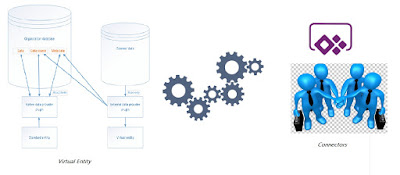PL 400: Determine when to build a virtual entity data source provider and when to use connectors
This article is the last part of the "Validated Requirements and Design Technical Architecture" section of the Technical Design in PL400 course curriculum and in this article, I will explain the last section of the above topic, i.e. "Determining when and when a virtual entity data source provider When to use connectors". Virtual entities and Connectors are integral parts of the Power Platform.
Virtual Entity:
A virtual entity is a definition of an entity in the Dynamics 365 platform metadata without the associated physical tables for entity instances created in the Dynamics 365 database. Instead during runtime, when an entity instance is required, its state is dynamically retrieved from the associated external system. Each virtual entity type is associated with a virtual entity data provider and (optionally) some configuration information from an associated virtual entity data source.
Usage:
Virtual Entity is part of previous version of Dynamics CRM, that means it is part of Model Driven App, as this app is completely dedicated on Dataverse. I couldn't find any reason to call it as entity because Microsoft recently changed the terminology entity to table. Studying this entity with limitation (e.g. read only data, organization owned and work without physical storage), I came to the following conclusion regarding the use of the Entity.
- Share real time price list of product, vendor, partner, competitor list to all users of CRM.
- Because of read only and organization owned, so we can use to share legacy data for strategic purposes to all.
- This entity is not physically stored, so we may retain data that can be used by all without payment value.
Connector:
A connector is a proxy or a wrapper around an API that allows the underlying service to talk to Microsoft Power Automate, Microsoft Power Apps, and Azure Logic Apps. It provides a way for users to connect their accounts and leverage a set of prebuilt actions and triggers to build their apps and workflows.
Usage :
This is the most recently introduced mechanism and is widely used with the Canvas app and Power Automate. It provides business application platform with access to external data. Overall, it acts as an intermediary or bridge to connect the data source and the apps.
- This empowers the Citizen Developer to work with the Power Platform along with other data sources.
- It is very useful tool for simple integration.












Comments
Post a Comment